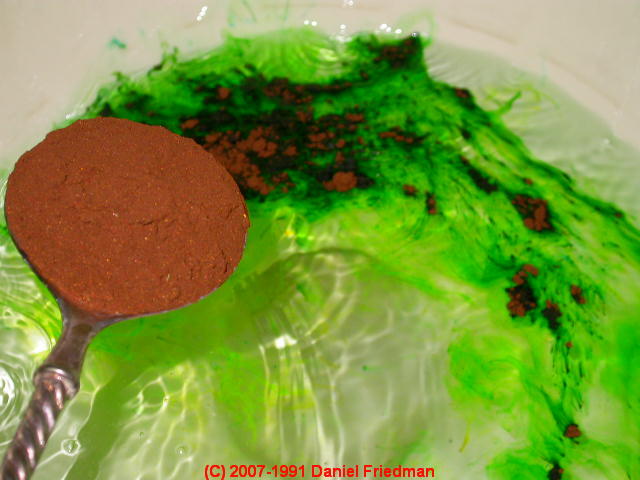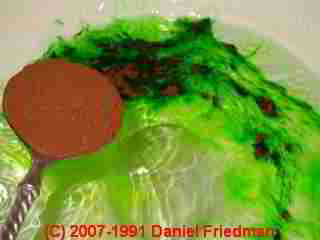 Indoor Steps to Take During a Septic Loading & Dye Test
Indoor Steps to Take During a Septic Loading & Dye Test
- POST a QUESTION or COMMENT about septic system testing: indoor procedures
Septic system testing: h
Here we describe in detail the exact steps to take indoors durin a septic test in order to assure that a septic loading & dye test is performed properly.
We describe avoiding a catastrophe such as spilling dyed water from an overlowing toilet, checking in the building for leaks before testing, checking during testing, and checking after septic testing.
InspectAPedia tolerates no conflicts of interest. We have no relationship with advertisers, products, or services discussed at this website.
- Daniel Friedman, Publisher/Editor/Author - See WHO ARE WE?
HOW TO PERFORM a SEPTIC DYE TEST - How to Properly Conduct a Septic Loading and Dye Test
This article series provides details of the Septic Loading and Dye Test procedure for testing the function of septic systems, focused on condition of the effluent disposal section, also known as a leach field, seepage pits, drainfield or drainage field.
Septic System Loading and Dye Tests often requested by certain lenders, involve flushing a special dye down a toilet or other drain combined with a known quantity of water sufficient to put a working load on the absorption system. If waste water leaks to the ground surface (an unsanitary condition indicating serious septic failure) one may find dye in that water provided the septic system is flowing at common rates.
Septic dye tests involve flushing a special florescent dye down a toilet or other drain. The dye itself does not make anything happen. It is simply a colored indicator that can identify water found outside as having come from the fixture where the dye was introduced.
It's the volume of water introduced into the system that forms the actual "test". If waste water is coming to the surface (an unsanitary condition indicating serious septic failure) one may see dye in that water, provided the septic system is flowing at common rates.
When suspect wet areas are observed, if the system has no maintenance history, if the area is known to have problem soils, or if other historic or site conditions raise question about the condition of the system we recommend that the inspector perform a dye test.
STEP BY STEP SEPTIC TEST GUIDE - Septic Loading & Dye Test Procedure
INSIDE STEPS - What to DO Inside the Building During a Septic Test
- Locate and inspect key inside septic system components:
- Location of the main house waste line exit point and cleanout.
- Location of any other drain lines leaving the building, possibly suggesting more than one septic tank or drywell
- Location, type, number of plumbing fixtures. Are there fixtures that are unlikely to be draining into the septic system because of their distance or elevation?
- Location and types of septic system pumps and alarms
- Report components that appear to be installed but which were not readily accessible for inspection.
- Run bathtub or sink water (cold faucet only) or similar fixture closest to where dye will be introduced (typically at a toilet in the next step).
- Confirm water flow into septic: Inspect DWV lines, particularly in the basement or crawl space, to assure that
the water being run is entering the septic system (as opposed to sinks and tubs being
routed to a drywell while the toilet (and dye source) is routed to a septic system. Check that the drains are in fact
connected and not spilling into the building. (E.g. where traps were removed for winterizing.)
Confirm that water flow from fixtures being run is going into the septic system or document that such confirmation was not possible. Often by running a test fixture the inspector can find and listen to the main waste line, confirming that the fixture is flowing into that drain. An access port at a septic tank may also permit this verification. - Flush the toilet with clean water where dye will (later) be introduced, assure it flushes normally so that you won't spill dye from an overflowing toilet into the building. Do not put dye into a toilet or other fixture before you have confirmed that the fixture will drain rather than backup and overflow into the building!
- Introduce dye into the toilet.(MUST use enough dye to stain no less than the
volume of the septic tank.
Typically this is 10 pellets or more and 2-3 tablespoons of dye. See the specs on the dye you buy,
see SEPTIC TEST VOLUMES & DYE AMOUNTS to determine how much septic dye powder or how many septic dye tablets to use, and what color septic dye to use.
Some tablets are so weak you'd need 200 to stain the effluent in the septic tank!
Watch out: to avoid creating a horrible mess with septic dye powder indoors, see our side-bar article:
See AVOID SEPTIC DYE POWDER CATASTROPHY that describes pre-wrapping packets of septic dye powder for indoor use.
Also see SEPTIC DYE TEST WARNINGS. - Record start time and estimated flow or measured GPM. Record all other pertinent descriptive factors as listed below.
- Run additional plumbing fixtures to obtain your total flow in GPM into the system and document which fixtures were run and the total GPM estimated or measured flow rate. Note that if the building is served by a private pump and well, the flow rate is not constant. The flow rate will vary as the pump on-off pressure cycle varies.
- Occupancy/Usage recording: note occupancy or time since last occupancy; note
number of occupants, number of bedrooms, number of bathrooms. Observe and
record separate handling of gray water and assure it's being discharged to an
approved location (not surface nor storm drains) if it's not flowing into the
septic system.
If the system has been recently pumped, or if a cesspool is installed, this test may be invalid: it may not be possible to run enough water during the test period to fill an empty or partly empty tank or cesspool.
A septic loading and dye test will by no means find every septic failure, but this methods finds many failures that otherwise are unnoticed by a home buyer until shortly after moving-in. Septic loading and dye tests are complimentary to and should precede any further inspection steps taken such as pumping the septic tank.
Dyed effluent usually appears in 20-30 minutes on a failed system but can take up to five days to show up. If at a building inspection suspect wet areas are observed I recommend a dye test even if one was not previously requested. When wet areas are not found (or created by running water into the septic system) on the property being inspected, dye tests may still be performed to meet requirements of some lenders.
Although this test can often find a costly failure it does not find all possible problems. So by itself a dye test is not indicative of complete condition of the system. On the other hand, I've found so many failed systems with this procedure that it's well worth performing.
Septic System Testing Articles
- SEPTIC & CESSPOOL SAFETY
- SEPTIC COMPONENT LOCATIONS
- SEPTIC INSPECTION & TEST LAWS & PROCEDURES
- SEPTIC LOADING & DYE TEST PROCEDURE - home
- SEPTIC SYSTEM BASICS
- SEPTIC SYSTEM INSPECTION CLASS
- SEPTIC SYSTEM INSPECTION & TEST GUIDE - home
...
Continue reading at AVOID SEPTIC DYE POWDER CATASTROPHY or select a topic from the closely-related articles below, or see the complete ARTICLE INDEX.
Suggested citation for this web page
INSIDE SEPTIC DYE TEST STEPS at InspectApedia.com - online encyclopedia of building & environmental inspection, testing, diagnosis, repair, & problem prevention advice.
Or see this
INDEX to RELATED ARTICLES: ARTICLE INDEX to SEPTIC SYSTEMS
Or use the SEARCH BOX found below to Ask a Question or Search InspectApedia
Ask a Question or Search InspectApedia
Questions & answers or comments about septic system testing: indoor procedures
Try the search box just below, or if you prefer, post a question or comment in the Comments box below and we will respond promptly.
Search the InspectApedia website
Note: appearance of your Comment below may be delayed: if your comment contains an image, photograph, web link, or text that looks to the software as if it might be a web link, your posting will appear after it has been approved by a moderator. Apologies for the delay.
Only one image can be added per comment but you can post as many comments, and therefore images, as you like.
You will not receive a notification when a response to your question has been posted.
Please bookmark this page to make it easy for you to check back for our response.
IF above you see "Comment Form is loading comments..." then COMMENT BOX - countable.ca / bawkbox.com IS NOT WORKING.
In any case you are welcome to send an email directly to us at InspectApedia.com at editor@inspectApedia.com
We'll reply to you directly. Please help us help you by noting, in your email, the URL of the InspectApedia page where you wanted to comment.
Citations & References
In addition to any citations in the article above, a full list is available on request.
- New York State Department of Health, APPENDIX 75-A WASTEWATER TREATMENT STANDARDS - INDIVIDUAL HOUSEHOLD SYSTEMS , [PDF] New York State Department of Health, 3 February 2010, retrieved 3/1/2010, original source: https://www.health.ny.gov/regulations/nycrr/title_10/part_75/appendix_75-a.htm
- Mark Cramer Inspection Services Mark Cramer, Tampa Florida, Mr. Cramer is a past president of ASHI, the American Society of Home Inspectors and is a Florida home inspector and home inspection educator. Mr. Cramer serves on the ASHI Home Inspection Standards. Contact Mark Cramer at: 727-595-4211 mark@BestTampaInspector.com
- John Cranor [Website: /www.house-whisperer.com ] is an ASHI member and a home inspector (The House Whisperer) is located in Glen Allen, VA 23060. He is also a contributor to InspectApedia.com in several technical areas such as plumbing and appliances (dryer vents). Contact Mr. Cranor at 804-873-8534 or by Email: johncranor@verizon.net
- Pennsylvania State Wastewater Treatment Fact Sheet SW-161, Septic System Failure: Diagnosis and Treatment
- Pennsylvania State Wastewater Treatment Fact Sheet SW-162, The Soil Media and the Percolation Test
- Pennsylvania State Wastewater Treatment Fact Sheet SW-l64, Mound Systems for Wastewater Treatment
- Pennsylvania State Wastewater Treatment Fact Sheet SW-165, Septic Tank-Soil Absorption Systems
- Document Sources used for this web page include but are not limited to: Agricultural Fact Sheet #SW-161 "Septic Tank Pumping," by Paul D. Robillard and Kelli S. Martin. Penn State College of Agriculture - Cooperative Extension, edited and annotated by Dan Friedman (Thanks: to Bob Mackey for proofreading the original source material.)
- Our recommended books about building & mechanical systems design, inspection, problem diagnosis, and repair, and about indoor environment and IAQ testing, diagnosis, and cleanup are at the InspectAPedia Bookstore. Also see our Book Reviews - InspectAPedia.
- In addition to citations & references found in this article, see the research citations given at the end of the related articles found at our suggested
CONTINUE READING or RECOMMENDED ARTICLES.
- Carson, Dunlop & Associates Ltd., 120 Carlton Street Suite 407, Toronto ON M5A 4K2. Tel: (416) 964-9415 1-800-268-7070 Email: info@carsondunlop.com. Alan Carson is a past president of ASHI, the American Society of Home Inspectors.
Thanks to Alan Carson and Bob Dunlop, for permission for InspectAPedia to use text excerpts from The HOME REFERENCE BOOK - the Encyclopedia of Homes and to use illustrations from The ILLUSTRATED HOME .
Carson Dunlop Associates provides extensive home inspection education and report writing material. In gratitude we provide links to tsome Carson Dunlop Associates products and services.


